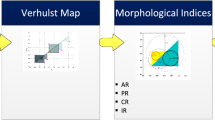Abstract
The Lyapunov exponents of synchronous 12-lead ECG signals have been investigated for the first time using a multi-sensor (electrode) technique. The results show that the Lyapunov exponents computed from different locations on the body surface are not the same, but have a distribution characteristic for the ECG signals recorded from coronary artery disease (CAD) patients with sinus rhythms and for signals from healthy older people. The maximum Lyapunov exponent L 1 of all signals is positive. While all the others are negative, so the ECG signal has chaotic characteristics. With the same leads, L 1 of CAD patients is less than that of healthy people, so the CAD patients and healthy people can be classified by L 1, L 1 therefore has potential values in the diagnosis of heart disease.
Similar content being viewed by others
References
Babloyantz, A., Destexhe, A., Is the normal heart a periodic oscillator? Biological Cybernetics, 1988, 58: 203.
Special Report: Heart rate variability-standards of measurement, physiological interpretation, and clinical use, Task Force of the European Society of Cardiology and the North American Society of Pacing and Electrophysiology, Circulation, 1996, 93(5): 1043.
Packard, N. H., Crutchfield, J. P., Farmer, J. D. et al., Geometry from a time series, Phys. Rev. Lett., 1980, 45: 712.
Takens, F., Detecting strange attractors in turbulence, Dynamical Systems and Turbulence, (eds. Randand, D., Young, L. -S.) Springer Lecture Notes in Mathematics, Vol. 898, Berlin: Spnnger-Verlag, 1981, 366.
Mane, R., On the dimension of the compact in variant set of certain non-linear maps, Dynamical Systems and Turbulence, (eds. Rand, D. A., Young, L. -S.), Springer Lecture Notes in Mathematics, Vol. 898, Berlin: Springer-Verlag, 1981, 320.
Wolf, A., Swift, J. B., Swinney, H. L. et al., Determining Lyapunov exponents from a time series, Physica D, 1985, 16: 285.
Eckmann, J. -P., Kamphorst, S. O., Lyapunov exponents from time series, Physical Review A, 1986, 34: 4971.
Ramasubramanian, K., Sriram, M. S., A comparative study of computation of Lyapunov spectra with different algorithms, Physica D, 2000, 139: 72.
Wang Zhenzhou, Ning Xinbao, Zhang Yu, et al., Distribution of correlation dimension of synchronous 12-lead ECG signals, Chinese Science Bulletin, 2000, 45(17): 1628.
Deering, W., West, B. J., Fractal physiology, IEEE Eng. Med. Bio., 1992: 40.
Goldberger, A. L., Fractal Mechanisms in the electrophysiology of the heart, IEEE Eng. Med. Bio., 1992: 47.
Author information
Authors and Affiliations
Corresponding author
About this article
Cite this article
Wang, Z., Li, Z., Wei, Y. et al. Lyapunov exponents for synchronous 12-lead ECG signals. Chin.Sci.Bull. 47, 1845–1848 (2002). https://doi.org/10.1007/BF03183855
Received:
Published:
Issue Date:
DOI: https://doi.org/10.1007/BF03183855




